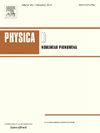Learning dynamical systems from noisy data with inverse-explicit integrators
IF 2.7
3区 数学
Q1 MATHEMATICS, APPLIED
引用次数: 0
Abstract
We introduce the mean inverse integrator (MII), a novel approach that improves accuracy when training neural networks to approximate vector fields of dynamical systems using noisy data. This method can be used to average multiple trajectories obtained by numerical integrators such as Runge–Kutta methods. We show that the class of mono-implicit Runge–Kutta methods (MIRK) offers significant advantages when used in connection with MII. When training vector field approximations, explicit expressions for the loss functions are obtained by inserting the training data in the MIRK formulae. This allows the use of symmetric and high-order integrators without requiring the solution of non-linear systems of equations. The combined approach of applying MIRK within MII yields a significantly lower error compared to the plain use of the numerical integrator without averaging the trajectories. This is demonstrated with extensive numerical experiments using data from chaotic and high-dimensional Hamiltonian systems. Additionally, we perform a sensitivity analysis of the loss functions under normally distributed perturbations, providing theoretical support for the favorable performance of MII and symmetric MIRK methods.
求助全文
约1分钟内获得全文
求助全文
来源期刊

Physica D: Nonlinear Phenomena
物理-物理:数学物理
CiteScore
7.30
自引率
7.50%
发文量
213
审稿时长
65 days
期刊介绍:
Physica D (Nonlinear Phenomena) publishes research and review articles reporting on experimental and theoretical works, techniques and ideas that advance the understanding of nonlinear phenomena. Topics encompass wave motion in physical, chemical and biological systems; physical or biological phenomena governed by nonlinear field equations, including hydrodynamics and turbulence; pattern formation and cooperative phenomena; instability, bifurcations, chaos, and space-time disorder; integrable/Hamiltonian systems; asymptotic analysis and, more generally, mathematical methods for nonlinear systems.
 求助内容:
求助内容: 应助结果提醒方式:
应助结果提醒方式:


